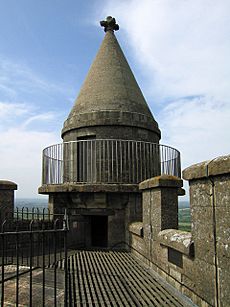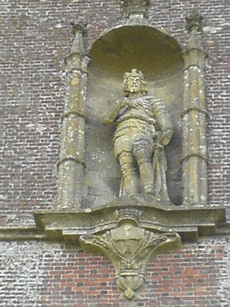King Alfred's Tower facts for kids
Quick facts for kids King Alfred's Tower |
|
|---|---|

King Alfred's Tower, August 2006
|
|
| General information | |
| Town or city | Brewham, Somerset |
| Country | England |
| Coordinates | 51°06′53″N 2°21′54″W / 51.1148273°N 2.3650446°W |
| Construction started | 1769 |
| Completed | 1772 |
| Client | Henry Hoare |
| Height | 49 metres (161 ft) |
| Design and construction | |
| Architect | Henry Flitcroft |
King Alfred's Tower, also known as The Folly of King Alfred the Great, is a unique tower. It stands in Somerset, England, as part of the Stourhead estate. A "folly" is a building built just for decoration or fun, not for a practical purpose. This tower is owned by the National Trust, a group that protects historic places. It is also a Grade I listed building, meaning it is very important historically.
The tower was planned in the 1760s by Henry Hoare II. It was built to celebrate the end of the Seven Years' War against France. It also honored King George III becoming king. The tower stands near 'Egbert's Stone'. This is where Alfred the Great, a famous King of Wessex, gathered his Saxons in May 878. This happened before the important Battle of Edington. In 1944, a plane crashed into the tower, causing damage. It was fixed up in the 1980s.
This triangular tower is 49-metre (161 ft)-high. It has a hollow center. You can climb to the top using a spiral staircase inside one of its corners. The tower also features a statue of King Alfred and a special message carved into its stone.
Contents
Where is King Alfred's Tower?
The tower is located near 'Egbert's Stone'. This spot is believed to be where Alfred the Great, the King of Wessex, gathered his Saxon army. They met in May 878 before the important Battle of Edington. In this battle, the Danish army, led by Guthrum the Old, was defeated.
The tower also marks the start of the Leland Trail. This is a 28-mile (45.1 km) walking path. It goes from King Alfred's Tower all the way to Ham Hill Country Park.
History of the Tower
The idea for the tower came from Henry Hoare II, a banker, in 1762. He wanted to build it to remember the end of the Seven Years' War. This was a big war against France. It also marked King George III becoming the new king.
Alfred's Tower is a monument to the genius of English landscape, many of whose loveliest haunts it commands, and to a man who certainly deserves to be remembered as among the great benefactors of the English scene.
—Christopher Hussey, Country Life, 11 June 1938.
In 1765, Henry Flitcroft, an architect, designed the tower. Building started in 1769 or early 1770. It was finished in 1772. The cost was about £5,000 to £6,000. Besides being a memorial, the tower was also meant to be a beautiful sight. It was a focal point for people visiting the Stourhead Estate. In April 1770, when the tower was only 4.7 metres (15 ft) tall, Hoare said he hoped it would be finished in good times for England.
The tower was damaged in 1944. A Noorduyn Norseman plane crashed into it. Five aircrew members died in the accident. The top 10 metres (33 ft) of the tower were damaged. In 1961, it was named a Grade I listed building. The tower was repaired in 1986. During the repair, a Wessex helicopter helped. It lowered a 300-kilogram (47 st) stone onto the very top. The statue of King Alfred was also fixed. His missing right arm was replaced.
How the Tower Looks
The tower is shaped like a triangle. It is over 40 metres (131 ft) tall. Each of its three corners has a round part sticking out. The middle of the tower is empty. A mesh has been put at the roof level to stop birds from flying inside.
To reach the top, you climb a 205-step spiral staircase. This staircase is in the corner farthest from the entrance. From the viewing platform, you can see the countryside all around. The platform has a crenellated parapet, which looks like the top of a castle wall. The tower is made of brick with special stone details.
The front (south-east) side of the tower has a Gothic-arched entrance door. Above the door, there is a statue of King Alfred. There is also a stone panel with an important message. This is the side most visitors see first.
The Tower's Inscription
There are several messages carved into stones around the Stourhead estate. The message on the tower was written in 1762. It was put on the tower in 1772. The stone tablet above the door on the east side of the tower says:
ALFRED THE GREAT
AD 879 on this Summit
Erected his Standard
Against Danish Invaders
To him We owe The Origin of Juries
The Establishment of a Militia
The Creation of a Naval Force
ALFRED The Light of a Benighted Age
Was a Philosopher and a Christian
The Father of his People
The Founder of the English
MONARCHY and LIBERTY
it:Stourhead#Alfred's Tower
See also
 In Spanish: Torre del rey Alfredo para niños
In Spanish: Torre del rey Alfredo para niños



